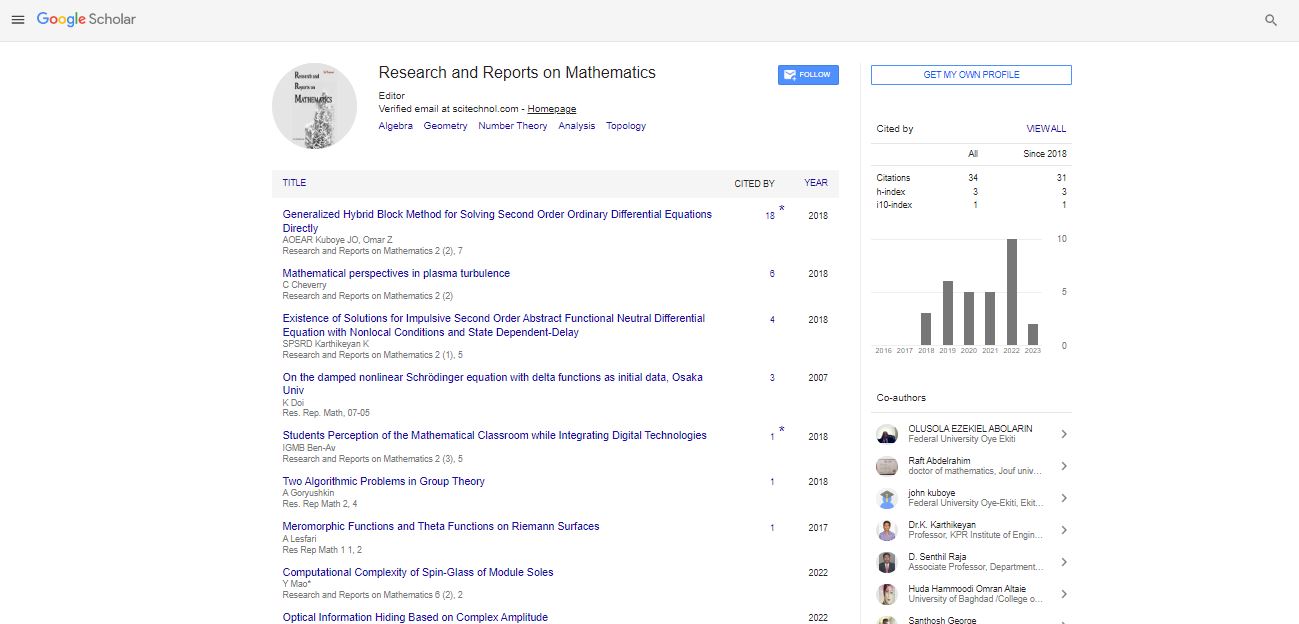Opinion Article, Res Rep Math Vol: 8 Issue: 1
Mathematical Insights into DNA: Topology and Knot Theory Approaches
Hardin Bake*
Department of Mathematics Education, University of Florida, Florida, USA
- *Corresponding Author:
- Hardin Bake
Department of Mathematics Education,
University of Florida,
Florida,
USA
E-mail: hardinbake123@gmail.com
Received date: 27 October, 2023, Manuscript No. RRM-23-118499;
Editor assigned date: 30 October, 2023, PreQC No. RRM-23-118499 (PQ);
Reviewed date: 13 November, 2023, QC No. RRM-23-118499;
Revised date: 11 January, 2024, Manuscript No. RRM-23-118499 (R);
Published date: 18 January, 2024, DOI: 10.4172/rrm.1000227
Citation: Bake H (2024) Mathematical Insights into DNA: Topology and Knot Theory Approaches. Res Rep Math 8:1.
Description
The fascinating intersection of mathematics, specifically topology and knot theory, with the realm of DNA research. DNA, the molecule of life, exhibits intricate spatial and structural properties that can be deciphered using mathematical tools. We explore the fundamentals of topology and knot theory and their applications in understanding DNA topology, supercoiling, and recombination. These mathematical approaches provide fresh insights into the biological processes that underlie genetics, DNA replication, and gene regulation.
DNA, the genetic blueprint of life, is a complex molecule with a rich and intricate structure. Beyond the familiar double helix, DNA exhibits a remarkable spatial organization that influences its functionality. Mathematics, particularly topology and knot theory, offers powerful tools for understanding the structural aspects of DNA. In this manuscript, we embark on a journey to explore the mathematical insights that illuminate the mysteries of DNA.
Topology, the branch of mathematics that studies properties preserved under continuous deformations, provides a foundation for understanding DNA's spatial structure. Concepts such as continuity, homeomorphism, and open sets play crucial roles in topological analysis.
Topological equivalence, or equivalence under continuous deformation, is a key idea that can be applied to DNA. DNA molecules with the same topological properties can undergo similar biological processes.
Knot theory
Knot theory is a specialized area of topology that delves into the study of mathematical knots, which are closed loops embedded in three-dimensional space. These loops can take on a bewildering array of forms, and knot theory provides tools for classifying, distinguishing, and understanding these structures. Knot theory is not only a fascinating area of pure mathematics but also has practical applications in physics, biology, and chemistry. Understanding the properties of knots is crucial in fields like DNA research and the study of polymers.
Together, topology and knot theory offer a mathematical lens through which to explore the structure of our world, from the shape of galaxies to the behavior of DNA molecules. These fields play a significant role in modern mathematics and science, facilitating deeper insights into the fundamental principles that govern our physical and abstract spaces.
Knot theory and DNA
Knot theory is the study of mathematical knots, which are closed loops embedded in three-dimensional space. DNA strands can be conceptualized as physical knots, and knot theory provides tools for analyzing and classifying these structures.
DNA supercoiling, the coiling of a DNA double helix upon itself, is a critical biological process that affects DNA compaction and gene regulation. Knot theory helps in understanding the topological intricacies of supercoiled DNA and its role in cellular processes.
Topological DNA analysis
The linking number is a topological invariant that quantifies the extent to which two DNA strands are intertwined. It is an essential measure in understanding the topological properties of DNA molecules.
DNA recombination is a biological process where DNA strands exchange segments. Topological approaches shed light on how recombination events are governed by the unlinking or linking of DNA strands.
Applications in genetics and molecular biology
The understanding of DNA topology and supercoiling is crucial in the replication process, where DNA unwinding and rewinding are essential steps.
DNA topology and knot theory provide insights into how DNA's spatial organization influences gene expression and regulation.
While topology and knot theory have brought significant insights to DNA research, there are still challenges to address, such as developing more efficient computational tools for analyzing large DNA datasets and further understanding the biological consequences of DNA topology.
Conclusion
Mathematics is the key that unlocks the potential of machine learning. It provides the formalism and tools necessary to understand, design, and optimize machine learning models. By embracing the mathematical foundations of machine learning, we can harness its power to solve complex problems and drive innovation in a wide range of domains.
 Spanish
Spanish  Chinese
Chinese  Russian
Russian  German
German  French
French  Japanese
Japanese  Portuguese
Portuguese  Hindi
Hindi 